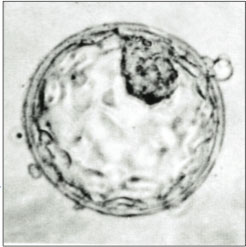Blastocyst


The blastocyst is a stage of development that occurs in most mammals. The blastocyst has two basic types of cells. One of them is called inner cell mass. This will form the embryo. The outer layer of cells will form the two membranes which surround the embryo.
In humans, the blastocyst starts to form about five days after fertilization. About seven days after fertilization, the blastocyst attaches itself to the wall of the uterus.
With in vitro fertilization, the fertilized egg gets transferred to the uterus. When this is done it is two to three days after fertilization. It is difficult to predict which eggs will develop best. For this reason, several are usually transferred to the uterus. Often this leads to multiple pregnancies (multiple eggs developing into embryos). When a blastocyst is transferred, five to six days after fertilization, this problem does not occur. It is also easier to transfer a blastocyst and attach it to the wall of the uterus.